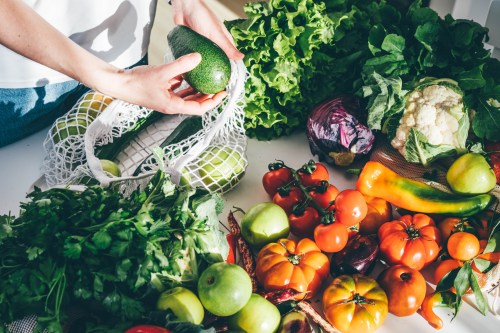The Clever Way an RD Boosts the Inflammation-Fighting Perks of (Nearly) Every Recipe
Discover three dietitian-approved anti-inflammatory cooking tips for making healthy comfort foods packed with tons of joy in every bite.

“Foods hold many purposes,” Sapna Bhalsod, RD, a registered dietitian for WellTheory reminds us. And while providing nourishment for your body is just one of them, she affirms that enjoying comfort foods is just as important to a balanced diet as staying hydrated and eating fiber.
Experts in This Article
registered dietitian for WellTheory
This concept is very much in line with one of Well+Good’s key wellness trends for 2024, where we predicted that joy would be a huge focus for healthy eating this year. The reason why we eat doesn’t always have to be exclusively tied to sustenance. Instead, comfort foods can be dual-purpose: evoke joy, while fueling you up with simple, nutritious, and most importantly, comforting ingredients. “You might be eating this meal because it reminds you of a fond memory, in a social gathering to connect with your community, or simply because you crave it,” Bhalsod says. All of which are very legitimate reasons to eat what makes you happiest.
The ultimate goal? Making comfort foods that not only bring you comfort (obvi), but also help you feel nourished from health perspective too. Ahead, the registered dietitian shares ways to incorporate anti-inflammatory cooking tips for making healthy comfort foods to your daily routine.
Anti-inflammatory cooking tips and 3 healthy comfort foods a dietitian loves
Everyone’s personal comfort food is different, because what brings you comfort is often specific to your unique tastes as well as your social and cultural context. For Bhalsod, nothing spells comfort like these three soul-warming foods: creamy Japanese purple sweet potatoes, berry-based ice cream, and fruit cobbler. “I like to recreate comfort meals that work with my diet by thinking through what I can add to the dish to help me feel more nourished,” Bhalsod says. For example, when making fruit cobbler, Bhalsod relies on fresh fruit and almond flour for the crunchy crumble topping, which add protein and fiber to the dish. Meanwhile, when making berry ice cream, she blends frozen fruits filled with antioxidants and fiber, and uses honey and nut milk to bring it all together.
Finally, Bhalsod says Japanese purple sweet potatoes on their own are simple, yet delicious, and offer a high amount of fiber, magnesium, and antioxidants. But they also pair well with just about anything you would add to a loaded baked potato. (And they’re a staple for Okinawans, who are known to be among the longest-living people in the world.)
How to boost the anti-inflammatory benefits of any recipe
Again, comfort foods can just be what they are: comforting. But if you’re looking to add extra nutritional benefit to your dish of choice and for some extra anti-inflammatory cooking tips, Bhalsod has some suggestions. “When it comes to comfort foods, it’s essential to consider what you can add to this food to help create a balanced plate,” she says. She often uses turmeric, ginger, and garlic in her cooking to amplify the anti-inflammatory benefits (and flavor) of even the most basic comfort food recipes.
“This trio is high in flavonoids and antioxidants that support your immune system and general health. They also add a punch of flavor to any dish,” Bhalsod says. I mean, doesn’t a pinch of warming ginger in a fruit cobbler sound absolutely divine? But if savory is what you’re in the mood for, the dietitian also recommends making warming, cozy dishes that feature these anti-inflammatory spices, like curry or a vegetable stir fry. Swoon.
In addition to spicing things up (pun intended), Bhalsod is mindful of using a wide array of fruits and vegetables whenever possible. This might mean adding spinach, eggs, and sweet potatoes to an otherwise plain oatmeal dish for a savory twist. As a rule of thumb, the dietitian says the “different colors from fruits and vegetables signify different nutrients and antioxidants,” which are important in creating a balanced meal.
If you want to go the extra mile, Bhalsod recommends considering how you prepare foods. “The way we cook our food can have a significant impact on its nutritional content. Different cooking methods affect the availability of nutrients by influencing the overall nutritional profile of the meal,” she says. “For example, you lose more water-soluble nutrients when you boil your vegetables versus when steaming them.”
That’s why Bhalsod recommends steaming foods to help maintain nutrient retention. “This gentle process helps preserve water-soluble vitamins and minerals that might be lost during boiling,” she says. That said, if steaming doesn’t vibe with the flavor or texture you want from your finished dish, then don’t feel like you have to prepare your food that way just to be healthy.
5-ingredient banana chocolate ice cream recipe
Yields 4 servings
Ingredients4 frozen bananas (peeled)1/4 cup cocoa powder2 Tbsp almond butter (can substitute for peanut butter)1/4 cup milk of choice (only use if you are making this in a food processor)Chocolate chunks or chips (optional, to sprinkle on top)
1. Place the frozen bananas, cocoa powder, and almond butter into a high-powered blender.2. Blend the bananas on high speed using the plunger to push the bananas down as needed. After two to three minutes the ice cream will run smoothly.3. Eat right away or freeze for two hours so that it’s hard enough to scoop into cones. Finally, sprinkle with chocolate chunks, if you’d like.
Easy vegan peach cobbler recipe:
Sign Up for Our Daily Newsletter
Get all the latest in wellness, trends, food, fitness, beauty, and more delivered right to your inbox.
Got it, you've been added to our email list.










